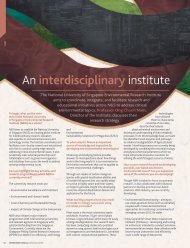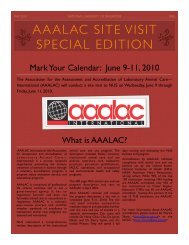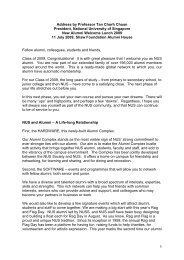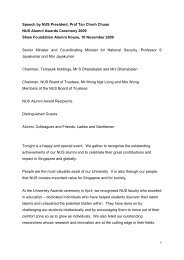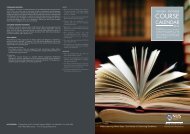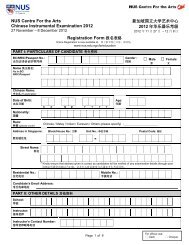Children using dictogloss to focus on form
Children using dictogloss to focus on form
Children using dictogloss to focus on form
You also want an ePaper? Increase the reach of your titles
YUMPU automatically turns print PDFs into web optimized ePapers that Google loves.
<str<strong>on</strong>g>Children</str<strong>on</strong>g> <str<strong>on</strong>g>using</str<strong>on</strong>g> <str<strong>on</strong>g>dic<str<strong>on</strong>g>to</str<strong>on</strong>g>gloss</str<strong>on</strong>g> <str<strong>on</strong>g>to</str<strong>on</strong>g> <str<strong>on</strong>g>focus</str<strong>on</strong>g> <strong>on</strong> <strong>form</strong> 47<br />
<str<strong>on</strong>g>Children</str<strong>on</strong>g> <str<strong>on</strong>g>using</str<strong>on</strong>g> <str<strong>on</strong>g>dic<str<strong>on</strong>g>to</str<strong>on</strong>g>gloss</str<strong>on</strong>g> <str<strong>on</strong>g>to</str<strong>on</strong>g><br />
<str<strong>on</strong>g>focus</str<strong>on</strong>g> <strong>on</strong> <strong>form</strong><br />
Juliana Shak<br />
Universiti Brunei Darussalam<br />
ABSTRACT<br />
This paper reports <strong>on</strong> a study investigating children’s attitudes <str<strong>on</strong>g>to</str<strong>on</strong>g>wards <str<strong>on</strong>g>dic<str<strong>on</strong>g>to</str<strong>on</strong>g>gloss</str<strong>on</strong>g>,<br />
a type of <str<strong>on</strong>g>focus</str<strong>on</strong>g> <strong>on</strong> <strong>form</strong> task designed <str<strong>on</strong>g>to</str<strong>on</strong>g> facilitate learners’ understanding of the<br />
target <strong>form</strong> in a meaning-<str<strong>on</strong>g>focus</str<strong>on</strong>g>ed c<strong>on</strong>text. The compatibility of this language teaching<br />
procedure with interests and motivati<strong>on</strong> of learners, in effect, provides a learner<br />
perspective of the effectiveness and usefulness of the task. This study can thus be<br />
seen as a preliminary step in determining the feasibility and effectiveness of<br />
incorporating <str<strong>on</strong>g>focus</str<strong>on</strong>g> <strong>on</strong> <strong>form</strong> (F<strong>on</strong>F) instructi<strong>on</strong> in<str<strong>on</strong>g>to</str<strong>on</strong>g> an upper primary ESL classroom.<br />
Specifically, the study addressed whether children found <str<strong>on</strong>g>dic<str<strong>on</strong>g>to</str<strong>on</strong>g>gloss</str<strong>on</strong>g> compatible with<br />
their interests, needs and motivati<strong>on</strong>, and whether teachers found <str<strong>on</strong>g>dic<str<strong>on</strong>g>to</str<strong>on</strong>g>gloss</str<strong>on</strong>g><br />
appropriate in terms of their learnability, teachability and task usefulness. A <str<strong>on</strong>g>to</str<strong>on</strong>g>tal of<br />
78 children from three Primary 5 classes in Brunei Darussalam <str<strong>on</strong>g>to</str<strong>on</strong>g>ok part in the study,<br />
and they were given attitude questi<strong>on</strong>naires at the end of each less<strong>on</strong>. Findings based<br />
<strong>on</strong> the children’s resp<strong>on</strong>ses show that there existed fluctuati<strong>on</strong>s in children’s attitudes<br />
<str<strong>on</strong>g>to</str<strong>on</strong>g> the task during the grammar less<strong>on</strong>s, thus providing a str<strong>on</strong>g implicati<strong>on</strong> that<br />
children’s <str<strong>on</strong>g>focus</str<strong>on</strong>g>, through manipulati<strong>on</strong> of task design and implementati<strong>on</strong>, could<br />
be reinforced <str<strong>on</strong>g>to</str<strong>on</strong>g> process the target feature as they per<strong>form</strong> the task. The results also<br />
suggest that further classroom research is needed <str<strong>on</strong>g>to</str<strong>on</strong>g> find ways for teachers <str<strong>on</strong>g>to</str<strong>on</strong>g> adapt<br />
the F<strong>on</strong>F approach <str<strong>on</strong>g>to</str<strong>on</strong>g> their specific classes.<br />
Introducti<strong>on</strong><br />
Recent findings of classroom research appear <str<strong>on</strong>g>to</str<strong>on</strong>g> dem<strong>on</strong>strate that <strong>form</strong><str<strong>on</strong>g>focus</str<strong>on</strong>g>ed<br />
instructi<strong>on</strong> is beneficial <str<strong>on</strong>g>to</str<strong>on</strong>g> learners in modifying their interlanguage<br />
grammar, thereby leading <str<strong>on</strong>g>to</str<strong>on</strong>g> improved linguistic accuracy in language use<br />
(Doughty & Williams, 1998; Ellis, 2002; Norris & Ortega, 2000). However, <str<strong>on</strong>g>to</str<strong>on</strong>g><br />
date, research has <str<strong>on</strong>g>focus</str<strong>on</strong>g>ed <strong>on</strong> general differences between <str<strong>on</strong>g>focus</str<strong>on</strong>g> <strong>on</strong> <strong>form</strong> (F<strong>on</strong>F)<br />
and <str<strong>on</strong>g>focus</str<strong>on</strong>g> <strong>on</strong> <strong>form</strong>s (F<strong>on</strong>FS) instructi<strong>on</strong>, or <strong>on</strong> the overall effectiveness of F<strong>on</strong>F<br />
per se based <strong>on</strong> the language outcomes of, mostly, advanced sec<strong>on</strong>d or foreign<br />
language learners. What is established in recent literature is the characterizati<strong>on</strong><br />
of F<strong>on</strong>F as a pedagogical interventi<strong>on</strong> that <str<strong>on</strong>g>focus</str<strong>on</strong>g>es primarily <strong>on</strong> meaning while<br />
attending <str<strong>on</strong>g>to</str<strong>on</strong>g> such linguistic elements as grammar, vocabulary and pr<strong>on</strong>unciati<strong>on</strong><br />
via communicative tasks (Ellis, 2001, p. 14). This is different from F<strong>on</strong>FS<br />
instructi<strong>on</strong> in that its emphasis is mostly <strong>on</strong> discrete pre-selected <strong>form</strong>(s), and it<br />
typically involves intensive and systematic treatment of those linguistic elements.<br />
There is usually a lack of corresp<strong>on</strong>dence between the <strong>form</strong>s practised and their<br />
use in ‘real’ discourse. Having said that, according <str<strong>on</strong>g>to</str<strong>on</strong>g> Basturkmen, Loewen and<br />
Reflecti<strong>on</strong>s <strong>on</strong> English Language Teaching, Vol. 5, No. 2, pp. 47-62
48 Juliana Shak<br />
Ellis (2004, p. 244), a <strong>form</strong> for attenti<strong>on</strong> can also be pre-selected for planned<br />
F<strong>on</strong>F instructi<strong>on</strong>, and incorporated in<str<strong>on</strong>g>to</str<strong>on</strong>g> the design of the task for learners <str<strong>on</strong>g>to</str<strong>on</strong>g><br />
‘notice’ and use, as in the case of the present study. The key tenet of F<strong>on</strong>F<br />
instructi<strong>on</strong> remains as “meaning and use must already be evident <str<strong>on</strong>g>to</str<strong>on</strong>g> the learner<br />
at the time that attenti<strong>on</strong> is drawn <str<strong>on</strong>g>to</str<strong>on</strong>g> the linguistic apparatus needed <str<strong>on</strong>g>to</str<strong>on</strong>g> get the<br />
meaning across” (Doughty & Williams, 1998, p. 4). The issue now that remains<br />
uncertain in the literature of F<strong>on</strong>F is how learners’ attenti<strong>on</strong> <str<strong>on</strong>g>to</str<strong>on</strong>g> grammar should<br />
be directed. There is still a lack of in<strong>form</strong>ati<strong>on</strong> for classroom practiti<strong>on</strong>ers <str<strong>on</strong>g>to</str<strong>on</strong>g><br />
determine what particular qualities or specific features of F<strong>on</strong>F tasks they can<br />
utilize <str<strong>on</strong>g>to</str<strong>on</strong>g> effectively shape learner language per<strong>form</strong>ance. One way <str<strong>on</strong>g>to</str<strong>on</strong>g> determine<br />
what works in a task is <str<strong>on</strong>g>to</str<strong>on</strong>g> obtain learner percepti<strong>on</strong> of the task.<br />
The present study c<strong>on</strong>cerns the attitudes of upper primary children <str<strong>on</strong>g>to</str<strong>on</strong>g>wards<br />
<str<strong>on</strong>g>dic<str<strong>on</strong>g>to</str<strong>on</strong>g>gloss</str<strong>on</strong>g>, a type of F<strong>on</strong>F task which proposes <str<strong>on</strong>g>to</str<strong>on</strong>g> provide a meaning-<str<strong>on</strong>g>focus</str<strong>on</strong>g>ed<br />
c<strong>on</strong>text <str<strong>on</strong>g>to</str<strong>on</strong>g> raise learners’ awareness of the discoursal use of the target linguistic<br />
feature. According <str<strong>on</strong>g>to</str<strong>on</strong>g> Wajnryb (1990, p. 5), the basic procedure of <str<strong>on</strong>g>dic<str<strong>on</strong>g>to</str<strong>on</strong>g>gloss</str<strong>on</strong>g><br />
c<strong>on</strong>sists of learners listening <str<strong>on</strong>g>to</str<strong>on</strong>g> a short text read <str<strong>on</strong>g>to</str<strong>on</strong>g> them at normal speed, and<br />
rec<strong>on</strong>structing the text, first individually, then in small groups, so that it has the<br />
same meaning as the original text. The various versi<strong>on</strong>s are then analyzed and<br />
compared in a whole class setting. In short, the task <str<strong>on</strong>g>focus</str<strong>on</strong>g>es not <strong>on</strong>ly <strong>on</strong> learner<br />
output, but also <strong>on</strong> learner interacti<strong>on</strong>. This is different from the traditi<strong>on</strong>al<br />
dictati<strong>on</strong> which requires learners <str<strong>on</strong>g>to</str<strong>on</strong>g> write down what is read by the teacher<br />
verbatim. What the present study aimed <str<strong>on</strong>g>to</str<strong>on</strong>g> do is <str<strong>on</strong>g>to</str<strong>on</strong>g> provide children a “voice” <str<strong>on</strong>g>to</str<strong>on</strong>g><br />
express their opini<strong>on</strong>s and preference of <str<strong>on</strong>g>dic<str<strong>on</strong>g>to</str<strong>on</strong>g>gloss</str<strong>on</strong>g> and its task features. After all,<br />
the role of affect is crucial in language learning. Krashen’s (1985, p. 3) Affective<br />
Filter emphasizes the importance of interest, motivati<strong>on</strong> and beliefs of learners<br />
in their acquisiti<strong>on</strong> of a language. Furthermore, Savign<strong>on</strong> (1997, p. 107) rightly<br />
stresses that the “ultimate success in learning <str<strong>on</strong>g>to</str<strong>on</strong>g> use a sec<strong>on</strong>d language most<br />
likely would be seen <str<strong>on</strong>g>to</str<strong>on</strong>g> depend <strong>on</strong> the attitude of the learner.” In this respect, the<br />
study is significant in that it provides an insight from the learners’ perspective<br />
in<str<strong>on</strong>g>to</str<strong>on</strong>g> the suitability of <str<strong>on</strong>g>dic<str<strong>on</strong>g>to</str<strong>on</strong>g>gloss</str<strong>on</strong>g> for the upper primary children.<br />
<str<strong>on</strong>g>Children</str<strong>on</strong>g> in Brunei Darussalam learn English as a sec<strong>on</strong>d language (L2) at<br />
school. The current method of teaching English in the Brunei primary schools<br />
revolves around the Reading and Language Acquisiti<strong>on</strong> (RELA) approach which,<br />
in essence, develops communicative activities through the reading process. The<br />
F<strong>on</strong>F approach in the present study aimed <str<strong>on</strong>g>to</str<strong>on</strong>g> take children a step further in the<br />
grammar instructi<strong>on</strong>. Here, <str<strong>on</strong>g>dic<str<strong>on</strong>g>to</str<strong>on</strong>g>gloss</str<strong>on</strong>g> takes the <strong>form</strong> of indirect explicit instructi<strong>on</strong><br />
which engages learners in active discussi<strong>on</strong> and explorati<strong>on</strong> of the target language.<br />
Ellis (1998, p. 48) argues that such an awareness-raising inductive opti<strong>on</strong> offers<br />
learners the opportunity <str<strong>on</strong>g>to</str<strong>on</strong>g> discover underlying patterns of the target structures<br />
for themselves, thereby increasing their motivati<strong>on</strong>.<br />
This study is part of a larger research project investigating attitudes of young<br />
learners and teachers <str<strong>on</strong>g>to</str<strong>on</strong>g>wards several grammar tasks. The findings provide<br />
implicati<strong>on</strong>s for possible implementati<strong>on</strong> of F<strong>on</strong>F instructi<strong>on</strong> at the upper primary<br />
level. In the present paper, however, we restrict our <str<strong>on</strong>g>focus</str<strong>on</strong>g> <str<strong>on</strong>g>to</str<strong>on</strong>g> the findings relating<br />
<str<strong>on</strong>g>to</str<strong>on</strong>g> <strong>on</strong>e specific grammar task, <str<strong>on</strong>g>dic<str<strong>on</strong>g>to</str<strong>on</strong>g>gloss</str<strong>on</strong>g>. Specifically, the study addressed the<br />
following research questi<strong>on</strong>s:
<str<strong>on</strong>g>Children</str<strong>on</strong>g> <str<strong>on</strong>g>using</str<strong>on</strong>g> <str<strong>on</strong>g>dic<str<strong>on</strong>g>to</str<strong>on</strong>g>gloss</str<strong>on</strong>g> <str<strong>on</strong>g>to</str<strong>on</strong>g> <str<strong>on</strong>g>focus</str<strong>on</strong>g> <strong>on</strong> <strong>form</strong> 49<br />
1. What are children’s attitudes <str<strong>on</strong>g>to</str<strong>on</strong>g>wards <str<strong>on</strong>g>dic<str<strong>on</strong>g>to</str<strong>on</strong>g>gloss</str<strong>on</strong>g>?<br />
2. What are teachers’ attitudes <str<strong>on</strong>g>to</str<strong>on</strong>g>wards <str<strong>on</strong>g>dic<str<strong>on</strong>g>to</str<strong>on</strong>g>gloss</str<strong>on</strong>g>?<br />
Dic<str<strong>on</strong>g>to</str<strong>on</strong>g>gloss as a F<strong>on</strong>F task<br />
If ‘noticing’, as put forward by Schmidt (1990, p. 129), is paramount <str<strong>on</strong>g>to</str<strong>on</strong>g> L2<br />
acquisiti<strong>on</strong>, the key issue, thus, is how <str<strong>on</strong>g>to</str<strong>on</strong>g> <str<strong>on</strong>g>focus</str<strong>on</strong>g> learners’ attenti<strong>on</strong> <strong>on</strong> linguistic<br />
features in the input (or output) in order <str<strong>on</strong>g>to</str<strong>on</strong>g> promote the development of their<br />
L2 competence. Dic<str<strong>on</strong>g>to</str<strong>on</strong>g>gloss is selected for this study because it allows for learners<br />
<str<strong>on</strong>g>to</str<strong>on</strong>g> engage in meaningful negotiati<strong>on</strong> while drawing their attenti<strong>on</strong> <str<strong>on</strong>g>to</str<strong>on</strong>g> linguistic<br />
<strong>form</strong>, thus rendering it as a F<strong>on</strong>F task. More significantly, it holds noticing, the<br />
main cognitive c<strong>on</strong>struct in F<strong>on</strong>F, as the essential comp<strong>on</strong>ent of instructi<strong>on</strong>.<br />
Dic<str<strong>on</strong>g>to</str<strong>on</strong>g>gloss overtly directs learner attenti<strong>on</strong> <str<strong>on</strong>g>to</str<strong>on</strong>g> differences between learners’<br />
interlanguage and the target language via the process of noticing-the-gap. Schmidt<br />
and Frota (1986) define noticing-the-gap as a process that requires learners <str<strong>on</strong>g>to</str<strong>on</strong>g><br />
make comparis<strong>on</strong>s between their current state of linguistic competence (in their<br />
output) and the target language (input). Based <strong>on</strong> Wajnryb’s (1990, p. 7)<br />
<str<strong>on</strong>g>dic<str<strong>on</strong>g>to</str<strong>on</strong>g>gloss</str<strong>on</strong>g> procedure, there are five basic stages in the grammar task in this study<br />
(see Appendix 1):<br />
● the Listening stage, in which the teacher prepares children for the <str<strong>on</strong>g>to</str<strong>on</strong>g>pic of the<br />
<str<strong>on</strong>g>dic<str<strong>on</strong>g>to</str<strong>on</strong>g>gloss</str<strong>on</strong>g> text via s<str<strong>on</strong>g>to</str<strong>on</strong>g>ry-telling and whole-class discussi<strong>on</strong>.<br />
● the Noticing stage, in which children listen <str<strong>on</strong>g>to</str<strong>on</strong>g> a short text read <str<strong>on</strong>g>to</str<strong>on</strong>g> them twice<br />
at normal speed. They may choose <str<strong>on</strong>g>to</str<strong>on</strong>g> take fragmentary notes during the<br />
sec<strong>on</strong>d reading. After that, they rec<strong>on</strong>struct their versi<strong>on</strong> of the original text<br />
individually.<br />
● the Activity stage, in which children work <str<strong>on</strong>g>to</str<strong>on</strong>g>gether in small groups <str<strong>on</strong>g>to</str<strong>on</strong>g><br />
rec<strong>on</strong>struct the text.<br />
● the Checking stage, in which children analyze and compare their various<br />
versi<strong>on</strong>s in a whole class setting. Here, the class written output is compared<br />
with the original text <str<strong>on</strong>g>to</str<strong>on</strong>g> find out which differences are acceptable.<br />
● the Writing stage, in which children are required <str<strong>on</strong>g>to</str<strong>on</strong>g> produce a similar text<br />
individually. This feature is not part of the original <str<strong>on</strong>g>dic<str<strong>on</strong>g>to</str<strong>on</strong>g>gloss</str<strong>on</strong>g> procedure. It is<br />
added <str<strong>on</strong>g>to</str<strong>on</strong>g> examine learner linguistic outcomes.<br />
It should be noted that the noticing process does not <strong>on</strong>ly take place in the<br />
Noticing stage. These stages were used <str<strong>on</strong>g>to</str<strong>on</strong>g> signal <str<strong>on</strong>g>to</str<strong>on</strong>g> teachers a change in the <str<strong>on</strong>g>focus</str<strong>on</strong>g><br />
of instructi<strong>on</strong>.<br />
The requirement for producti<strong>on</strong> in the target language in the Noticing stage<br />
may trigger learners <str<strong>on</strong>g>to</str<strong>on</strong>g> become c<strong>on</strong>sciously aware of their current language<br />
competence as they attempt <str<strong>on</strong>g>to</str<strong>on</strong>g> rec<strong>on</strong>struct the text. However, it is at the<br />
comparis<strong>on</strong> phase in Activity when their attenti<strong>on</strong> is directed <str<strong>on</strong>g>to</str<strong>on</strong>g> notice the disparity<br />
between the target language and their own output that the process of noticingthe-gap<br />
is activated. Swain (1999, p. 145) observes that “Students gain insights<br />
in<str<strong>on</strong>g>to</str<strong>on</strong>g> their own linguistic shortcomings and develop strategies for solving them<br />
by working through them with a partner.” This process which involves cognitive<br />
comparis<strong>on</strong> tends not <strong>on</strong>ly <str<strong>on</strong>g>to</str<strong>on</strong>g> raise learners’ awareness of certain grammatical
50 Juliana Shak<br />
structures but also <str<strong>on</strong>g>to</str<strong>on</strong>g> re<strong>form</strong>ulate their hypotheses of the structures as they modify<br />
their output.<br />
Other than foc<str<strong>on</strong>g>using</str<strong>on</strong>g> <strong>on</strong> negative feedback, the noticing-the-gap process may<br />
also help assimilate positive evidence or c<strong>on</strong>firmati<strong>on</strong> of, for instance, how certain<br />
linguistic <strong>form</strong>s work, as provided by the original text during the comparis<strong>on</strong><br />
phase, and serves <str<strong>on</strong>g>to</str<strong>on</strong>g> c<strong>on</strong>solidate learners’ existing knowledge. Additi<strong>on</strong>ally, in<br />
the process of noticing-the-gap, <str<strong>on</strong>g>dic<str<strong>on</strong>g>to</str<strong>on</strong>g>gloss</str<strong>on</strong>g> allows for learners at different levels<br />
and with different needs <str<strong>on</strong>g>to</str<strong>on</strong>g> notice different language features (Thornbury, 1999,<br />
p. 85). This implies that the restructuring process occurs at learners’ current stage<br />
of interlanguage development.<br />
The effectiveness of <str<strong>on</strong>g>dic<str<strong>on</strong>g>to</str<strong>on</strong>g>gloss</str<strong>on</strong>g> has yet <str<strong>on</strong>g>to</str<strong>on</strong>g> be fully researched, in particular<br />
with respect <str<strong>on</strong>g>to</str<strong>on</strong>g> young learners. There are several empirical studies <str<strong>on</strong>g>to</str<strong>on</strong>g> illustrate<br />
the effectiveness of <str<strong>on</strong>g>dic<str<strong>on</strong>g>to</str<strong>on</strong>g>gloss</str<strong>on</strong>g> in promoting learners’ grammatical competence.<br />
Kowal and Swain (1994, p. 78), for instance, in their research <strong>on</strong> 19 intermediate<br />
and advanced learners of French found evidence of grammatical improvements<br />
of learners when they worked <str<strong>on</strong>g>to</str<strong>on</strong>g>gether <str<strong>on</strong>g>to</str<strong>on</strong>g> rec<strong>on</strong>struct the text. They c<strong>on</strong>clude<br />
that <str<strong>on</strong>g>dic<str<strong>on</strong>g>to</str<strong>on</strong>g>gloss</str<strong>on</strong>g> promotes syntactic processing skills. Kuiken and Vedder (2002)<br />
reported that their qualitative analysis revealed interacti<strong>on</strong> in the rec<strong>on</strong>structi<strong>on</strong><br />
phase often stimulated noticing.<br />
Murray (1994, p. 79), <strong>on</strong> the other hand, in her investigati<strong>on</strong> <str<strong>on</strong>g>to</str<strong>on</strong>g> verify the<br />
effectiveness of <str<strong>on</strong>g>dic<str<strong>on</strong>g>to</str<strong>on</strong>g>gloss</str<strong>on</strong>g> in terms of verbal interacti<strong>on</strong>, collaborati<strong>on</strong> and<br />
c<strong>on</strong>sciousness raising of specific linguistic features, did not find data <str<strong>on</strong>g>to</str<strong>on</strong>g> support<br />
the claim that <str<strong>on</strong>g>dic<str<strong>on</strong>g>to</str<strong>on</strong>g>gloss</str<strong>on</strong>g> can be used <str<strong>on</strong>g>to</str<strong>on</strong>g> <str<strong>on</strong>g>focus</str<strong>on</strong>g> learners’ attenti<strong>on</strong> <strong>on</strong> specific<br />
features of language. Furthermore, the task structure appeared <str<strong>on</strong>g>to</str<strong>on</strong>g> create c<strong>on</strong>flicts<br />
and frustrati<strong>on</strong> am<strong>on</strong>g her 14 Swiss EFL university students as they had no means<br />
of evaluating the accuracy and acceptability of soluti<strong>on</strong>s during the verbal<br />
interacti<strong>on</strong>. In another study, del Pilar García Mayo (2002, p. 161) reported that<br />
when completing the <str<strong>on</strong>g>dic<str<strong>on</strong>g>to</str<strong>on</strong>g>gloss</str<strong>on</strong>g>, her advanced EFL learners seemed <str<strong>on</strong>g>to</str<strong>on</strong>g> be more<br />
c<strong>on</strong>cerned about the <strong>form</strong> and meaning of words and expressi<strong>on</strong>s than about<br />
the features targeted by the task. In short, <str<strong>on</strong>g>dic<str<strong>on</strong>g>to</str<strong>on</strong>g>gloss</str<strong>on</strong>g> did not help her students <str<strong>on</strong>g>to</str<strong>on</strong>g><br />
<str<strong>on</strong>g>focus</str<strong>on</strong>g> <strong>on</strong> specific linguistic features.<br />
Findings from both studies provide caveats for the preparati<strong>on</strong> of the<br />
<str<strong>on</strong>g>dic<str<strong>on</strong>g>to</str<strong>on</strong>g>gloss</str<strong>on</strong>g> text for the present research. Two features seem <str<strong>on</strong>g>to</str<strong>on</strong>g> play a causal role in<br />
determining the success of the task:<br />
● the level of language used in the text should be compatible with the learners’<br />
linguistic ability;<br />
● the target language features should be made apparent <str<strong>on</strong>g>to</str<strong>on</strong>g> the learners, and<br />
this can be achieved through recurrences of the features within the text.<br />
Thus, the text for this study is modified <str<strong>on</strong>g>to</str<strong>on</strong>g> take in<str<strong>on</strong>g>to</str<strong>on</strong>g> account these two features<br />
(see Appendix 2). It differs from other <str<strong>on</strong>g>dic<str<strong>on</strong>g>to</str<strong>on</strong>g>gloss</str<strong>on</strong>g> texts in that it is less dense with<br />
in<strong>form</strong>ati<strong>on</strong> and is seeded with recurrences of the target structure. In effect, it<br />
serves as structured input for the young learners.
<str<strong>on</strong>g>Children</str<strong>on</strong>g> <str<strong>on</strong>g>using</str<strong>on</strong>g> <str<strong>on</strong>g>dic<str<strong>on</strong>g>to</str<strong>on</strong>g>gloss</str<strong>on</strong>g> <str<strong>on</strong>g>to</str<strong>on</strong>g> <str<strong>on</strong>g>focus</str<strong>on</strong>g> <strong>on</strong> <strong>form</strong> 51<br />
The study<br />
Participants<br />
Three intact classes of Primary 5 children (from three different schools) <str<strong>on</strong>g>to</str<strong>on</strong>g>ok<br />
part in the experimental treatment. The class sizes were 28, 24 and 26 for Groups<br />
1, 2 and 3 respectively. Groups 1 and 3 were mixed ability classes. Even so, there<br />
was an uneven distributi<strong>on</strong> of children in terms of English proficiency level (EPL)<br />
in Group 1 (comprising of 3 high EPL, 8 middle EPL and 17 low EPL, whereas<br />
Group 3 c<strong>on</strong>sisted of 6 high EPL, 15 middle EPL and 5 low EPL). <str<strong>on</strong>g>Children</str<strong>on</strong>g>’s EPL<br />
was determined by their respective English language teachers <strong>on</strong> the basis of<br />
their language per<strong>form</strong>ance in class and previous English test score. The placement<br />
of children in Group 2 was based <strong>on</strong> the overall score of their first assessment<br />
given at the beginning of the year. This class was c<strong>on</strong>sidered the high ability<br />
class. At the time when the research was c<strong>on</strong>ducted, children in all three schools<br />
received similar instructi<strong>on</strong> and language c<strong>on</strong>tent as determined by the nati<strong>on</strong>al<br />
English curriculum.<br />
Data collecti<strong>on</strong><br />
The instruments developed for this study included a student-attitude<br />
questi<strong>on</strong>naire, a teacher-attitude questi<strong>on</strong>naire and a grammar task. The studentattitude<br />
questi<strong>on</strong>naire c<strong>on</strong>sisted of both open and closed questi<strong>on</strong>s (see Appendix<br />
3). It was distributed <str<strong>on</strong>g>to</str<strong>on</strong>g> children at the end of each less<strong>on</strong>. The three teachers<br />
who administered the experimental treatment were also required <str<strong>on</strong>g>to</str<strong>on</strong>g> complete a<br />
teacher-attitude questi<strong>on</strong>naire after each less<strong>on</strong>. The questi<strong>on</strong>naire comprised<br />
open and closed questi<strong>on</strong>s and was designed <str<strong>on</strong>g>to</str<strong>on</strong>g> examine teachers’ attitudes<br />
<str<strong>on</strong>g>to</str<strong>on</strong>g>wards, and opini<strong>on</strong>s about, <str<strong>on</strong>g>dic<str<strong>on</strong>g>to</str<strong>on</strong>g>gloss</str<strong>on</strong>g> in terms of its teachability, learnability<br />
and task usefulness (see Appendix 4). The grammar task was designed for an<br />
hour of daily use over a two-day period (i.e. two less<strong>on</strong>s). This was <str<strong>on</strong>g>to</str<strong>on</strong>g> provide<br />
task repetiti<strong>on</strong> and recycling for the target grammatical structure, as well as <str<strong>on</strong>g>to</str<strong>on</strong>g><br />
familiarize children with the procedures involved in the task.<br />
For <str<strong>on</strong>g>dic<str<strong>on</strong>g>to</str<strong>on</strong>g>gloss</str<strong>on</strong>g>, the target <strong>form</strong> was ‘did not’ + base <strong>form</strong>. This language feature<br />
was selected based <strong>on</strong> a free s<str<strong>on</strong>g>to</str<strong>on</strong>g>ry-writing task given <str<strong>on</strong>g>to</str<strong>on</strong>g> two mixed-ability classes<br />
of Primary 5 children prior <str<strong>on</strong>g>to</str<strong>on</strong>g> this research. From their writing, it was found that<br />
‘did not’ + base <strong>form</strong> was <strong>on</strong>e of the more problematic linguistic <strong>form</strong>s, and as<br />
such, was chosen as <str<strong>on</strong>g>focus</str<strong>on</strong>g> of this grammar task.<br />
Less<strong>on</strong> plans, teachers’ notes and task material for Dic<str<strong>on</strong>g>to</str<strong>on</strong>g>gloss Days 1 and 2<br />
were given <str<strong>on</strong>g>to</str<strong>on</strong>g> all three teachers so as <str<strong>on</strong>g>to</str<strong>on</strong>g> ensure that instructi<strong>on</strong>al treatment was<br />
similar for all groups. At the end of each less<strong>on</strong>, a written task was given (the<br />
Writing stage). For Dic<str<strong>on</strong>g>to</str<strong>on</strong>g>gloss Day 1, children were required <str<strong>on</strong>g>to</str<strong>on</strong>g> complete a<br />
sentence, and for Dic<str<strong>on</strong>g>to</str<strong>on</strong>g>gloss Day 2, they were <str<strong>on</strong>g>to</str<strong>on</strong>g> compose a short text. Scores for<br />
the written tasks were recorded.<br />
Procedures<br />
Dic<str<strong>on</strong>g>to</str<strong>on</strong>g>gloss was c<strong>on</strong>ducted for two days. Each day the three groups received<br />
an hour of F<strong>on</strong>F instructi<strong>on</strong> <strong>on</strong> the same target <strong>form</strong>, following the steps outlined
52 Juliana Shak<br />
<strong>on</strong> page 49. Attitude questi<strong>on</strong>naires were administered <str<strong>on</strong>g>to</str<strong>on</strong>g> children and their<br />
respective teachers immediately after each less<strong>on</strong> <str<strong>on</strong>g>to</str<strong>on</strong>g> determine their attitudes<br />
<str<strong>on</strong>g>to</str<strong>on</strong>g>wards the grammar task.<br />
Findings and discussi<strong>on</strong>s<br />
1. What are children’s attitudes <str<strong>on</strong>g>to</str<strong>on</strong>g>wards <str<strong>on</strong>g>dic<str<strong>on</strong>g>to</str<strong>on</strong>g>gloss</str<strong>on</strong>g>?<br />
Items <str<strong>on</strong>g>to</str<strong>on</strong>g> evaluate learner attitudes <str<strong>on</strong>g>to</str<strong>on</strong>g>wards <str<strong>on</strong>g>dic<str<strong>on</strong>g>to</str<strong>on</strong>g>gloss</str<strong>on</strong>g> were scored <strong>on</strong> a three<br />
point Likert scale with a choice of 1-Yes, 3-Not sure and 5-No. Resp<strong>on</strong>ses were<br />
calculated <str<strong>on</strong>g>to</str<strong>on</strong>g> give the means and SDs of each less<strong>on</strong>, as shown in Table 1.<br />
<str<strong>on</strong>g>Children</str<strong>on</strong>g> generally showed a favourable attitude <str<strong>on</strong>g>to</str<strong>on</strong>g>wards <str<strong>on</strong>g>dic<str<strong>on</strong>g>to</str<strong>on</strong>g>gloss</str<strong>on</strong>g>, as<br />
indicated in the mean scores of less than 2.5 for all items. It was clear, for instance,<br />
that a majority of the children had enjoyed the task, with the means ranging<br />
from 1.8 (SD=1.3) <strong>on</strong> Day 1 <str<strong>on</strong>g>to</str<strong>on</strong>g> 1.4 (SD=1.1) <strong>on</strong> Day 2. The mean value of 2.3 for<br />
I think I did well for this activity was very high <str<strong>on</strong>g>to</str<strong>on</strong>g>wards No when compared with<br />
other attitude statements. Their perceived per<strong>form</strong>ance was apparently not<br />
matched by their high level of enjoyment, particularly <strong>on</strong> Day 1. This suggests a<br />
general lack of c<strong>on</strong>fidence am<strong>on</strong>g children in their task per<strong>form</strong>ance. A possible<br />
explanati<strong>on</strong> for this is the unfamiliarity of the task. Moreover, children were not<br />
accus<str<strong>on</strong>g>to</str<strong>on</strong>g>med <str<strong>on</strong>g>to</str<strong>on</strong>g> the type of cognitive demands induced by the F<strong>on</strong>F approach,<br />
thus resulting in c<strong>on</strong>siderable variati<strong>on</strong> am<strong>on</strong>g learners’ opini<strong>on</strong> of the grammar<br />
instructi<strong>on</strong>, in particular for Item 4 of Day 1 (M=2.3, SD=1.7).<br />
Table 1<br />
Means and SDs of children’s attitude scores based <strong>on</strong> <str<strong>on</strong>g>dic<str<strong>on</strong>g>to</str<strong>on</strong>g>gloss</str<strong>on</strong>g><br />
4. I want <str<strong>on</strong>g>to</str<strong>on</strong>g> do<br />
1. I enjoyed doing 2. I think this 3. I think I did more activities<br />
Dic<str<strong>on</strong>g>to</str<strong>on</strong>g>gloss this activity activity was easy well in this activity like this<br />
N M SD M SD M SD M SD<br />
Day 1 78 1.8 1.3 2.2 1.4 2.3 1.2 2.3 1.7<br />
Day 2 78 1.4 1.1 1.6 1.1 1.9 1.3 1.7 1.4<br />
Table 2<br />
Means and SDs of attitude scores am<strong>on</strong>g the three groups for <str<strong>on</strong>g>dic<str<strong>on</strong>g>to</str<strong>on</strong>g>gloss</str<strong>on</strong>g><br />
4. I want <str<strong>on</strong>g>to</str<strong>on</strong>g> do<br />
1. I enjoyed doing 2. I think this 3. I think I did more activities<br />
Dic<str<strong>on</strong>g>to</str<strong>on</strong>g>gloss this activity activity was easy well in this activity like this<br />
N *G1 G2 G3 G1 G2 G3 G1 G2 G3 G1 G2 G3<br />
Day 1 M 2.6 1.3 1.5 2.3 1.9 2.4 2.8 1.7 2.5 2.7 1.7 2.5<br />
SD 1.4 0.9 1.3 1.1 1.3 1.8 1.3 1.1 1.1 1.6 1.4 1.8<br />
Day 2 M 1.2 1.3 1.7 1.5 1.6 1.7 2.0 1.6 2.2 1.2 1.7 2.3<br />
SD 0.6 0.9 1.5 1.0 1.3 1.1 1.4 1.1 1.3 0.6 1.4 1.8<br />
*G refers <str<strong>on</strong>g>to</str<strong>on</strong>g> Group
<str<strong>on</strong>g>Children</str<strong>on</strong>g> <str<strong>on</strong>g>using</str<strong>on</strong>g> <str<strong>on</strong>g>dic<str<strong>on</strong>g>to</str<strong>on</strong>g>gloss</str<strong>on</strong>g> <str<strong>on</strong>g>to</str<strong>on</strong>g> <str<strong>on</strong>g>focus</str<strong>on</strong>g> <strong>on</strong> <strong>form</strong> 53<br />
In particular for Group 1, it was obvious that the task complexity led <str<strong>on</strong>g>to</str<strong>on</strong>g> low<br />
interest and motivati<strong>on</strong>. Dic<str<strong>on</strong>g>to</str<strong>on</strong>g>gloss was a completely new task for them. <str<strong>on</strong>g>Children</str<strong>on</strong>g><br />
in Groups 2 and 3 were familiar with the c<strong>on</strong>cept of Dictati<strong>on</strong> and as such, were<br />
not as affected by the novelty of the task. Thus, it was of no surprise that the<br />
means in Table 2 showed children in Group 1 expressing more negative attitudes<br />
about, for instance, their per<strong>form</strong>ance than the other two groups <strong>on</strong> Day 1 (M=2.8,<br />
SD=1.3).<br />
In resp<strong>on</strong>se <str<strong>on</strong>g>to</str<strong>on</strong>g> an open questi<strong>on</strong> in the attitude questi<strong>on</strong>naire regarding her<br />
views <strong>on</strong> Dic<str<strong>on</strong>g>to</str<strong>on</strong>g>gloss Day 1, <strong>on</strong>e child from Group 1 noted:<br />
activity ini saya tidak faham. [B1Q1(13)] •<br />
*<br />
• B1Q1(13) refers <str<strong>on</strong>g>to</str<strong>on</strong>g>: B1=Less<strong>on</strong> B Day 1; Q1=Item 1 in the questi<strong>on</strong>naire; (13)=student no. 13<br />
* All italicized words within parenthesis indicate the translated versi<strong>on</strong>.<br />
Another child from Group 1 reflected <strong>on</strong> the frustrati<strong>on</strong> he felt during the task:<br />
This activity so difficult because I cannot understand some of this activity.<br />
[B1Q1(25)]<br />
On Day 2 all three groups were given the opportunity <str<strong>on</strong>g>to</str<strong>on</strong>g> repeat the task. There<br />
was an overall improvement in attitudes <str<strong>on</strong>g>to</str<strong>on</strong>g>wards the task <strong>on</strong> Day 2. Comments<br />
from the respective children were:<br />
… this activity is easy becese I NOW I answer this questi<strong>on</strong> sebab saya sudah<br />
faham. [B2Q2(13)]<br />
<br />
Because this activity can do me remember all the s<str<strong>on</strong>g>to</str<strong>on</strong>g>ry. This activity is not<br />
difficult and I can answer all the questi<strong>on</strong> in the box. [B2Q1(25)]<br />
Thus, it can be c<strong>on</strong>cluded that <strong>on</strong>e of the fac<str<strong>on</strong>g>to</str<strong>on</strong>g>rs that led <str<strong>on</strong>g>to</str<strong>on</strong>g> an increase in<br />
their positive attitudes in terms of enjoyment, perceived per<strong>form</strong>ance and<br />
motivati<strong>on</strong> was their familiarity with the task demands. In other words, the gradual<br />
mastery of a task can influence learner attitudes which in turn leads <str<strong>on</strong>g>to</str<strong>on</strong>g> further<br />
progress in task per<strong>form</strong>ance. Notably, children in Group 3 reported a lower<br />
level of motivati<strong>on</strong> (i.e. Item 4) for Day 2 (M=2.3, SD=1.8) than the other two<br />
groups. This str<strong>on</strong>gly suggests the likelihood of other fac<str<strong>on</strong>g>to</str<strong>on</strong>g>rs, such as the design<br />
of the task or interactive opportunities, affecting children’s attitudes.<br />
To gain greater insight in<str<strong>on</strong>g>to</str<strong>on</strong>g> the preferences of children in the particular<br />
qualities or specific features of <str<strong>on</strong>g>dic<str<strong>on</strong>g>to</str<strong>on</strong>g>gloss</str<strong>on</strong>g>, they were asked <str<strong>on</strong>g>to</str<strong>on</strong>g> identify the stage<br />
they especially liked or disliked in Write <strong>on</strong>e thing you liked about the activity and<br />
Write <strong>on</strong>e thing you d<strong>on</strong>’t like about the activity. It was found that the Noticing stage,<br />
which entails initial producti<strong>on</strong> in the target language, was referred <str<strong>on</strong>g>to</str<strong>on</strong>g> most<br />
frequently in children’s comments. On both Days 1 and 2 there were more positive<br />
comments than negative <strong>on</strong>es. Their comments include:<br />
I like about remember the s<str<strong>on</strong>g>to</str<strong>on</strong>g>ry. [B2Q5(30)]<br />
I like <str<strong>on</strong>g>to</str<strong>on</strong>g> listend the s<str<strong>on</strong>g>to</str<strong>on</strong>g>ry and write it in the boxes. [B1Q5(67)]<br />
I love the listen and write. [B1Q5(54)]
54 Juliana Shak<br />
However, the forte of <str<strong>on</strong>g>dic<str<strong>on</strong>g>to</str<strong>on</strong>g>gloss</str<strong>on</strong>g> lies in its ability <str<strong>on</strong>g>to</str<strong>on</strong>g> activate another level of<br />
noticing, i.e. noticing-the-gap, as children modify their output. The following<br />
extract taken from a child in Group 3 illustrates how she modified her output at<br />
different stages of the <str<strong>on</strong>g>dic<str<strong>on</strong>g>to</str<strong>on</strong>g>gloss</str<strong>on</strong>g> instructi<strong>on</strong>.<br />
Box A: On my own<br />
1. I can’t not go <str<strong>on</strong>g>to</str<strong>on</strong>g> my friend’s party.<br />
2. I can’t not watching tv.<br />
3. I can’t not eat any Ice-cerem.<br />
Box B: With my friends<br />
Last week I was sick.<br />
I can’t not go <str<strong>on</strong>g>to</str<strong>on</strong>g> my friend’s party.<br />
I can’t not eat any Ice-cerem.<br />
I did not wacting tv.<br />
I can’t not play game.<br />
I stayed at the bed at whole day.<br />
Box C: With the class<br />
Last week I was sick. I did not go <str<strong>on</strong>g>to</str<strong>on</strong>g> my friend’s party. I did not eat<br />
any ice-cream. I did not watch TV. I did not play any games. I just<br />
stayed in bed the whole day.<br />
<str<strong>on</strong>g>Children</str<strong>on</strong>g>’s partiality for such a process as cognitive comparis<strong>on</strong> was seen in<br />
some of their written testim<strong>on</strong>ies. Their stated reas<strong>on</strong>s, however, were not directed<br />
<str<strong>on</strong>g>to</str<strong>on</strong>g> the underlying principles of cognitive processing (nor were they expected <str<strong>on</strong>g>to</str<strong>on</strong>g>).<br />
Instead, they referred <str<strong>on</strong>g>to</str<strong>on</strong>g> various activity types used in <str<strong>on</strong>g>dic<str<strong>on</strong>g>to</str<strong>on</strong>g>gloss</str<strong>on</strong>g> <str<strong>on</strong>g>to</str<strong>on</strong>g> induce noticing.<br />
Check s<str<strong>on</strong>g>to</str<strong>on</strong>g>ry with teacher. [B2Q1(10)]<br />
I like share with class. [B1Q5(27)]<br />
Saya suka aktiviti yang berbincang sama kawan dan membuat sama-sama.<br />
[B2Q5(74)]<br />
<br />
Activity, which incorporated interactive group work, was seen <str<strong>on</strong>g>to</str<strong>on</strong>g> be the sec<strong>on</strong>d<br />
most frequently referred <str<strong>on</strong>g>to</str<strong>on</strong>g> task feature in the children’s comments for Days 1<br />
and 2. <str<strong>on</strong>g>Children</str<strong>on</strong>g> in all three groups, though not unanimous, expressed their<br />
enjoyment and preference <str<strong>on</strong>g>to</str<strong>on</strong>g> work with their friends.<br />
Saya suka membuat cerita sama-sama. [B1Q5(42)]<br />
<br />
I d<strong>on</strong>’t likes do <strong>on</strong> my own. [B1Q6(51)]<br />
I want <str<strong>on</strong>g>to</str<strong>on</strong>g> writing with friend. [B2Q5(28)]<br />
I like about this activity always work <str<strong>on</strong>g>to</str<strong>on</strong>g>gether as a team. [B2Q5(40)]<br />
The third most prominent task feature that received numerous positive<br />
resp<strong>on</strong>ses from children was Listening. Apparently, children liked <str<strong>on</strong>g>to</str<strong>on</strong>g> listen <str<strong>on</strong>g>to</str<strong>on</strong>g>
<str<strong>on</strong>g>Children</str<strong>on</strong>g> <str<strong>on</strong>g>using</str<strong>on</strong>g> <str<strong>on</strong>g>dic<str<strong>on</strong>g>to</str<strong>on</strong>g>gloss</str<strong>on</strong>g> <str<strong>on</strong>g>to</str<strong>on</strong>g> <str<strong>on</strong>g>focus</str<strong>on</strong>g> <strong>on</strong> <strong>form</strong> 55<br />
s<str<strong>on</strong>g>to</str<strong>on</strong>g>ries, particularly that of Moody Mimi. Am<strong>on</strong>gst their comments were:<br />
I liked about the activity is about listen the s<str<strong>on</strong>g>to</str<strong>on</strong>g>ry. [B1Q5(25)]<br />
<strong>on</strong>e thing I like the activity about my teacher s<str<strong>on</strong>g>to</str<strong>on</strong>g>ry. [B1Q5(36)]<br />
I like <str<strong>on</strong>g>to</str<strong>on</strong>g> listening about Moody Mimi. [B2Q5(14)]<br />
The Writing stage, <strong>on</strong> the other hand, received the most comments for being<br />
the task feature they disliked most <strong>on</strong> Day 2. Based <strong>on</strong> children’s resp<strong>on</strong>ses <str<strong>on</strong>g>to</str<strong>on</strong>g><br />
the attitude questi<strong>on</strong>naire, it appears that the producti<strong>on</strong> load may deter their<br />
interests in a grammar task. In this case, children found <str<strong>on</strong>g>dic<str<strong>on</strong>g>to</str<strong>on</strong>g>gloss</str<strong>on</strong>g> less desirable<br />
due <str<strong>on</strong>g>to</str<strong>on</strong>g> the written task they had <str<strong>on</strong>g>to</str<strong>on</strong>g> complete at the end of the less<strong>on</strong>. One child’s<br />
comment was:<br />
I d<strong>on</strong>’t like about this activity is the writing because it so very hard. [B2Q6(40)]<br />
Another major c<strong>on</strong>cern of this study was whether children felt they had learnt<br />
from the instructi<strong>on</strong>al treatment. This was posed as Have you learnt anything from<br />
this activity? If yes, what? in the attitude questi<strong>on</strong>naire. Affirmative resp<strong>on</strong>ses for<br />
both days of <str<strong>on</strong>g>dic<str<strong>on</strong>g>to</str<strong>on</strong>g>gloss</str<strong>on</strong>g> were 88.5%, indicating that most children felt they had<br />
learnt from <str<strong>on</strong>g>dic<str<strong>on</strong>g>to</str<strong>on</strong>g>gloss</str<strong>on</strong>g>. On the other end of the c<strong>on</strong>tinuum, five out of 78 students<br />
resp<strong>on</strong>ded that they had not learned anything <strong>on</strong> Day 1. Three children resp<strong>on</strong>ded<br />
negatively <strong>on</strong> Day 2. For children who felt they were positively affected by the<br />
tasks, their resp<strong>on</strong>ses of what they had learnt fell in<str<strong>on</strong>g>to</str<strong>on</strong>g> five distinguishable<br />
categories:<br />
● the target <strong>form</strong><br />
I lernt did not + present tens played ˚play¸ [B1Q7(77)]<br />
I learnt ‘did not’ back have present tense. [B2Q7(55)]<br />
● lexical items<br />
I have learned the ‘did not brush’. [B2Q7(59)]<br />
Yes take become <str<strong>on</strong>g>to</str<strong>on</strong>g>ok [B2Q7(61)]<br />
● how <str<strong>on</strong>g>to</str<strong>on</strong>g> per<strong>form</strong> the activity<br />
I learnt about the activity is about remember the s<str<strong>on</strong>g>to</str<strong>on</strong>g>ry and write in the box.<br />
[B2Q7(25)]<br />
Yes, remembering the sentences/words that my teacher has read. [B2Q7(46)]<br />
● moral of the s<str<strong>on</strong>g>to</str<strong>on</strong>g>ry<br />
Yes d<strong>on</strong>’t be lazy. [B2Q7(26)]<br />
I learn about Mimi lazy day. [B2Q7(69)]<br />
● general language skills<br />
Yes about write the s<str<strong>on</strong>g>to</str<strong>on</strong>g>ry with your friend. [B2Q7(1)]<br />
I learnt about write the s<str<strong>on</strong>g>to</str<strong>on</strong>g>ry <strong>on</strong> my own [B2Q7(20)]<br />
The diversity of resp<strong>on</strong>ses from children indicates that though the <str<strong>on</strong>g>dic<str<strong>on</strong>g>to</str<strong>on</strong>g>gloss</str<strong>on</strong>g><br />
text was modified <str<strong>on</strong>g>to</str<strong>on</strong>g> elicit a specific <strong>form</strong>, children’s learning was not c<strong>on</strong>fined<br />
<str<strong>on</strong>g>to</str<strong>on</strong>g> the grammar instructi<strong>on</strong>. Rather, the communicative c<strong>on</strong>text within <str<strong>on</strong>g>dic<str<strong>on</strong>g>to</str<strong>on</strong>g>gloss</str<strong>on</strong>g><br />
empowers individual children by providing them the exposure and practice of a<br />
range of structures and patterns in the target language, thus increasing their<br />
reper<str<strong>on</strong>g>to</str<strong>on</strong>g>ire of linguistic choices. The following extract, for instance, shows that a<br />
child in Group 2 was able <str<strong>on</strong>g>to</str<strong>on</strong>g> pick up the use of the c<strong>on</strong>tracted <strong>form</strong> didn’t after<br />
several discussi<strong>on</strong>s and comparis<strong>on</strong> of text, even though it was not the exact<br />
<strong>form</strong> in <str<strong>on</strong>g>focus</str<strong>on</strong>g> in the <str<strong>on</strong>g>dic<str<strong>on</strong>g>to</str<strong>on</strong>g>gloss</str<strong>on</strong>g> instructi<strong>on</strong>.
56 Juliana Shak<br />
Box A: On my own<br />
I d<strong>on</strong>’t go <str<strong>on</strong>g>to</str<strong>on</strong>g> my friend party.<br />
I d<strong>on</strong>’t eat ice-cream.<br />
I d<strong>on</strong>’t watch TV<br />
I d<strong>on</strong>’t play games<br />
Box B: With my friends<br />
Last day I were was sick. I d<strong>on</strong>’t go <str<strong>on</strong>g>to</str<strong>on</strong>g> my friend party. I d<strong>on</strong>’t eat<br />
ice-cream. I d<strong>on</strong>’t watched televisi<strong>on</strong> and I d<strong>on</strong>’t played any game.<br />
I just stay at my bed for the whole day.<br />
Box C: With the class<br />
Last week I was sick. I didn’t go <str<strong>on</strong>g>to</str<strong>on</strong>g> my friend’s party. I didn’t eat<br />
ice-cream. I didn’t watch televisi<strong>on</strong> and I didn’t play any games. I<br />
just stayed in my bed for the whole day.<br />
The use of collaborative rec<strong>on</strong>structi<strong>on</strong> of text is seen here <str<strong>on</strong>g>to</str<strong>on</strong>g> provide children<br />
with a valuable opportunity <str<strong>on</strong>g>to</str<strong>on</strong>g> notice the gap between their current level of L2<br />
proficiency and their target competence.<br />
2. What are teachers’ attitudes <str<strong>on</strong>g>to</str<strong>on</strong>g>wards <str<strong>on</strong>g>dic<str<strong>on</strong>g>to</str<strong>on</strong>g>gloss</str<strong>on</strong>g>?<br />
The three teachers, T1, T2 and T3, from Groups 1, 2 and 3 respectively were<br />
asked <str<strong>on</strong>g>to</str<strong>on</strong>g> complete a teacher attitude questi<strong>on</strong>naire after the implementati<strong>on</strong> of<br />
<str<strong>on</strong>g>dic<str<strong>on</strong>g>to</str<strong>on</strong>g>gloss</str<strong>on</strong>g> <strong>on</strong> Days 1 and 2. Their resp<strong>on</strong>ses provided insights in<str<strong>on</strong>g>to</str<strong>on</strong>g> the practical<br />
relevance of the task, specifically with respect <str<strong>on</strong>g>to</str<strong>on</strong>g> its learnability, teachability and<br />
task usefulness. Table 3 presents the mean attitude scores of teachers for <str<strong>on</strong>g>dic<str<strong>on</strong>g>to</str<strong>on</strong>g>gloss</str<strong>on</strong>g>.<br />
The analysis, showing mean scores of 2.0 or less for most attitude items,<br />
indicated that the three teachers who implemented the F<strong>on</strong>F treatment were<br />
generally positive <str<strong>on</strong>g>to</str<strong>on</strong>g>wards the task, particularly <strong>on</strong> Day 2. Closer inspecti<strong>on</strong> of<br />
individual resp<strong>on</strong>ses, however, revealed two opposing views <str<strong>on</strong>g>to</str<strong>on</strong>g> the teachability<br />
of <str<strong>on</strong>g>dic<str<strong>on</strong>g>to</str<strong>on</strong>g>gloss</str<strong>on</strong>g>. Whereas T2 and T3 viewed <str<strong>on</strong>g>dic<str<strong>on</strong>g>to</str<strong>on</strong>g>gloss</str<strong>on</strong>g> as easy <str<strong>on</strong>g>to</str<strong>on</strong>g> implement, T1 felt<br />
Table 3<br />
Mean attitude scores of teachers for <str<strong>on</strong>g>dic<str<strong>on</strong>g>to</str<strong>on</strong>g>gloss</str<strong>on</strong>g><br />
Attitude item (Questi<strong>on</strong> 3) Day 1 Day 2<br />
a. The activity was useful in helping children improve their English language. 2.0 1.3<br />
b. <str<strong>on</strong>g>Children</str<strong>on</strong>g> enjoyed the activity. 2.0 1.3<br />
c. <str<strong>on</strong>g>Children</str<strong>on</strong>g> found the activity easy <str<strong>on</strong>g>to</str<strong>on</strong>g> understand. 2.0 2.0<br />
d. The activity helped children <str<strong>on</strong>g>to</str<strong>on</strong>g> understand the grammar point/s in <str<strong>on</strong>g>focus</str<strong>on</strong>g>. 2.0 1.3<br />
e. The activity was easy <str<strong>on</strong>g>to</str<strong>on</strong>g> carry out. 2.0 1.3<br />
f. The activity was time-c<strong>on</strong>suming. 2.3 2.3<br />
g. I would like <str<strong>on</strong>g>to</str<strong>on</strong>g> have more activities like this <strong>on</strong>e for the children in my class. 2.0 1.3
<str<strong>on</strong>g>Children</str<strong>on</strong>g> <str<strong>on</strong>g>using</str<strong>on</strong>g> <str<strong>on</strong>g>dic<str<strong>on</strong>g>to</str<strong>on</strong>g>gloss</str<strong>on</strong>g> <str<strong>on</strong>g>to</str<strong>on</strong>g> <str<strong>on</strong>g>focus</str<strong>on</strong>g> <strong>on</strong> <strong>form</strong> 57<br />
the procedure <str<strong>on</strong>g>to</str<strong>on</strong>g>o complicated for her children. T2 and T3 also reported highly<br />
favourable attitudes from their children regarding the 2-day less<strong>on</strong>. Accordingly,<br />
the two teachers had introduced the task as a game, and this increased their<br />
children’s motivati<strong>on</strong> <str<strong>on</strong>g>to</str<strong>on</strong>g> a great extent (M=1.3 <strong>on</strong> Day 2). Teachers’ overall<br />
comments of the less<strong>on</strong> were:<br />
… most of them did not understand <strong>on</strong> how <str<strong>on</strong>g>to</str<strong>on</strong>g> share their s<str<strong>on</strong>g>to</str<strong>on</strong>g>ry and write it<br />
in Box B. I d<strong>on</strong>’t think the pupils can grasp the grammar taught in the less<strong>on</strong>.<br />
[T1Q1B1(1)]*<br />
*[T1Q1B1(1)] refers <str<strong>on</strong>g>to</str<strong>on</strong>g>: T1=teacher from Group 1; Q1=1st questi<strong>on</strong>naire;<br />
B1=Less<strong>on</strong> B Day 1; (1)=questi<strong>on</strong> 1.<br />
I think most enjoyed the activity about the teacher (me) being sick. Then they<br />
have <str<strong>on</strong>g>to</str<strong>on</strong>g> rewrite the s<str<strong>on</strong>g>to</str<strong>on</strong>g>ry; they treated it like a game. Then, sharing the s<str<strong>on</strong>g>to</str<strong>on</strong>g>ry<br />
with their friends was extremely fun for them as a whole class. [T2Q2(6)]<br />
… there is a lot of interacti<strong>on</strong> going <strong>on</strong> and tasks for Day 1 and 2 were similar<br />
so even the weaker pupils could follow through. They enjoyed and had fun in<br />
doing the activity. I also enjoyed teaching this activity. [T3Q2(7)]<br />
Both T2 and T3 found negotiated interacti<strong>on</strong>s effective as “most of my pupils<br />
noticed the ‘did not’ + verb when they have <str<strong>on</strong>g>to</str<strong>on</strong>g> discuss with their friends and<br />
rewrite it again” [T3Q1B1(2)]. During interacti<strong>on</strong>, some of the children’s shared<br />
linguistic input included not <strong>on</strong>ly the target <strong>form</strong>, but also other in<strong>form</strong>ati<strong>on</strong><br />
such as discourse features, vocabulary, spelling and punctuati<strong>on</strong> as they attempted<br />
<str<strong>on</strong>g>to</str<strong>on</strong>g> rec<strong>on</strong>struct the original meaning (as indicated in the extracts <strong>on</strong> pages 54 and<br />
56). This, as revealed in the teachers’ summati<strong>on</strong> of their less<strong>on</strong>s, was particularly<br />
helpful for developing children’s L2 proficiency. For T1, <strong>on</strong> the other hand, the<br />
most difficult part of <str<strong>on</strong>g>dic<str<strong>on</strong>g>to</str<strong>on</strong>g>gloss</str<strong>on</strong>g> was “Having the pupils sharing their s<str<strong>on</strong>g>to</str<strong>on</strong>g>ry and<br />
writing it down in box B, and asking them <str<strong>on</strong>g>to</str<strong>on</strong>g> write what they’ve learned in the<br />
grammar box” [T1Q1B1(5)]. Apparently, the strategy of ‘negotiating for meaning’<br />
<str<strong>on</strong>g>to</str<strong>on</strong>g> enable children <str<strong>on</strong>g>to</str<strong>on</strong>g> work out the linguistic gaps did not work in her class.<br />
T1’s observati<strong>on</strong> <strong>on</strong> both counts presented an important caveat for the<br />
implementati<strong>on</strong> of <str<strong>on</strong>g>dic<str<strong>on</strong>g>to</str<strong>on</strong>g>gloss</str<strong>on</strong>g>. As pointed out, it is imperative for children <str<strong>on</strong>g>to</str<strong>on</strong>g><br />
understand the message (and the task procedure) before they proceed <str<strong>on</strong>g>to</str<strong>on</strong>g> the<br />
group discussi<strong>on</strong> and writing phases. Because the <str<strong>on</strong>g>focus</str<strong>on</strong>g> was <strong>on</strong> <strong>form</strong>, the text<br />
used for Group 1 should have been, ideally, slightly below par with their linguistic<br />
competence so as <str<strong>on</strong>g>to</str<strong>on</strong>g> ensure that they could afford attenti<strong>on</strong> <strong>on</strong> the intended<br />
structure instead of having <str<strong>on</strong>g>to</str<strong>on</strong>g> struggle with the semantic features. In principle,<br />
<str<strong>on</strong>g>dic<str<strong>on</strong>g>to</str<strong>on</strong>g>gloss</str<strong>on</strong>g> directs children’s attenti<strong>on</strong> <str<strong>on</strong>g>to</str<strong>on</strong>g> the intended <strong>form</strong> via ‘noticing-the-gap’,<br />
and the wider the gap (in meaning and in linguistic input), the less likely children<br />
will succeed in the rec<strong>on</strong>structi<strong>on</strong> process. In the case of T1’s class, most of the<br />
children may have experienced great difficulty in <str<strong>on</strong>g>using</str<strong>on</strong>g> negotiated interacti<strong>on</strong>s<br />
during the rec<strong>on</strong>structi<strong>on</strong> of text due <str<strong>on</strong>g>to</str<strong>on</strong>g> the wide gaps they encountered in their<br />
understanding.<br />
T1 and T3 highlighted the significance of task repetiti<strong>on</strong> in helping children<br />
improve in their L2 task per<strong>form</strong>ance, especially for lower proficiency children.<br />
After the implementati<strong>on</strong> of <str<strong>on</strong>g>dic<str<strong>on</strong>g>to</str<strong>on</strong>g>gloss</str<strong>on</strong>g> <strong>on</strong> Day 2, T1 commented “The less<strong>on</strong>
58 Juliana Shak<br />
went well because I think they’ve familiarized and unders<str<strong>on</strong>g>to</str<strong>on</strong>g>od the previous less<strong>on</strong><br />
taught … I think it’s good <str<strong>on</strong>g>to</str<strong>on</strong>g> use this activity if the pupils are familiar with the<br />
exercises and activity d<strong>on</strong>e in the class” [T1Q1B2(1)]. On the whole, her resp<strong>on</strong>ses<br />
regarding the learnability, teachability and task usefulness of <str<strong>on</strong>g>dic<str<strong>on</strong>g>to</str<strong>on</strong>g>gloss</str<strong>on</strong>g> were more<br />
positive <strong>on</strong> Day 2. Both T1 and T2 also noted that children in their class found<br />
the Writing stage <strong>on</strong> Day 2 difficult as “they tend <str<strong>on</strong>g>to</str<strong>on</strong>g> use the wr<strong>on</strong>g tenses as they<br />
added more words <strong>on</strong> their own” [T2Q1B2(5)]. In particular for T1, it was felt<br />
that some adaptati<strong>on</strong>s were needed <str<strong>on</strong>g>to</str<strong>on</strong>g> cater for lower EPL children.<br />
Summary and discussi<strong>on</strong>s<br />
Research <strong>on</strong> <str<strong>on</strong>g>focus</str<strong>on</strong>g> <strong>on</strong> <strong>form</strong> (F<strong>on</strong>F) <str<strong>on</strong>g>to</str<strong>on</strong>g> date has given little attenti<strong>on</strong> <str<strong>on</strong>g>to</str<strong>on</strong>g> the<br />
particular qualities of F<strong>on</strong>F tasks that might give rise <str<strong>on</strong>g>to</str<strong>on</strong>g> learner interest or that<br />
learners might perceive <str<strong>on</strong>g>to</str<strong>on</strong>g> be useful in helping them shape their language<br />
per<strong>form</strong>ance. In this study it can be seen that while there was a general trend of<br />
positive attitudes am<strong>on</strong>g children <str<strong>on</strong>g>to</str<strong>on</strong>g>wards <str<strong>on</strong>g>dic<str<strong>on</strong>g>to</str<strong>on</strong>g>gloss</str<strong>on</strong>g>, variati<strong>on</strong>s <str<strong>on</strong>g>to</str<strong>on</strong>g>wards<br />
preference of task features existed. The main sources of influence in children’s<br />
attitudinal evaluati<strong>on</strong> of the task appear <str<strong>on</strong>g>to</str<strong>on</strong>g> be its producti<strong>on</strong> load (the Writing<br />
stage), cognitive load (the Noticing stage), interacti<strong>on</strong> opportunities (the Activity<br />
stage) and material design (the Listening stage). <str<strong>on</strong>g>Children</str<strong>on</strong>g> tended <str<strong>on</strong>g>to</str<strong>on</strong>g> rate the task<br />
more positively if they perceived it as <strong>on</strong>e that is cognitively stimulating, yet not<br />
overly demanding, and that presented lesser producti<strong>on</strong> demands. They also<br />
expressed particular partiality for s<str<strong>on</strong>g>to</str<strong>on</strong>g>ries and humorous characters, which also<br />
served as additi<strong>on</strong>al c<strong>on</strong>textual support. Some children, though not all, seemed<br />
<str<strong>on</strong>g>to</str<strong>on</strong>g> display a preference for working with friends during <str<strong>on</strong>g>dic<str<strong>on</strong>g>to</str<strong>on</strong>g>gloss</str<strong>on</strong>g>. Teachers <str<strong>on</strong>g>to</str<strong>on</strong>g>o<br />
highlighted cognitive load (specifically, task repetiti<strong>on</strong>), linguistic demands (for<br />
children <str<strong>on</strong>g>to</str<strong>on</strong>g> comprehend and <str<strong>on</strong>g>to</str<strong>on</strong>g> produce), and learner interacti<strong>on</strong> opportunities<br />
as criteria that influenced their percepti<strong>on</strong> of the grammar task.<br />
Proficiency appears <str<strong>on</strong>g>to</str<strong>on</strong>g> affect the task per<strong>form</strong>ance of low EPL children. This<br />
was clearly expressed by T1 in her utility of <str<strong>on</strong>g>dic<str<strong>on</strong>g>to</str<strong>on</strong>g>gloss</str<strong>on</strong>g>. Dic<str<strong>on</strong>g>to</str<strong>on</strong>g>gloss sought the use<br />
of negotiated interacti<strong>on</strong>s, partly <str<strong>on</strong>g>to</str<strong>on</strong>g> allow for opportunities <str<strong>on</strong>g>to</str<strong>on</strong>g> engage<br />
meaningfully in L2, and partly, <str<strong>on</strong>g>to</str<strong>on</strong>g> provide scaffolding via collaborati<strong>on</strong> (Kowal<br />
and Swain, 1994) <str<strong>on</strong>g>to</str<strong>on</strong>g> fill the linguistic gaps (which, in principle, should result in<br />
children being “pushed” <str<strong>on</strong>g>to</str<strong>on</strong>g> higher levels of per<strong>form</strong>ance). Yet, in the case of<br />
Group 1, with a substantial majority of the children in the lower end of EPL,<br />
<strong>on</strong>e can perceive how the supposedly aiding group work would become very<br />
demanding (for both the teacher and learners) <str<strong>on</strong>g>to</str<strong>on</strong>g> carry out meaningful<br />
communicati<strong>on</strong> in L2, let al<strong>on</strong>e <str<strong>on</strong>g>to</str<strong>on</strong>g> obtain student-generated correct <strong>form</strong>(s) during<br />
exchanges. This, coupled with the deliberati<strong>on</strong> of discovery learning of the task<br />
(in which learners were primed <str<strong>on</strong>g>to</str<strong>on</strong>g> notice and <str<strong>on</strong>g>to</str<strong>on</strong>g> <strong>form</strong>ulate rules for themselves),<br />
would explain the low attainment in the grammar task am<strong>on</strong>g the less proficient<br />
children in Group 1. The other two teachers, whose classes which c<strong>on</strong>sisted of<br />
more high and middle EPL children, found the negotiated interacti<strong>on</strong>s helpful.<br />
These findings corresp<strong>on</strong>d largely with other research <strong>on</strong> the effects of F<strong>on</strong>F<br />
instructi<strong>on</strong> (Williams, 2001) as well as the crucial role of attenti<strong>on</strong> in language<br />
learning (Schmidt, 1990; VanPatten, 2002). From a pedagogical perspective, the
<str<strong>on</strong>g>Children</str<strong>on</strong>g> <str<strong>on</strong>g>using</str<strong>on</strong>g> <str<strong>on</strong>g>dic<str<strong>on</strong>g>to</str<strong>on</strong>g>gloss</str<strong>on</strong>g> <str<strong>on</strong>g>to</str<strong>on</strong>g> <str<strong>on</strong>g>focus</str<strong>on</strong>g> <strong>on</strong> <strong>form</strong> 59<br />
findings have an important implicati<strong>on</strong>, in that teachers need <str<strong>on</strong>g>to</str<strong>on</strong>g> take in<str<strong>on</strong>g>to</str<strong>on</strong>g> account<br />
their children’s L2 proficiency level, in additi<strong>on</strong> <str<strong>on</strong>g>to</str<strong>on</strong>g> their (mental) age and grade<br />
level, before deciding <str<strong>on</strong>g>to</str<strong>on</strong>g> implement F<strong>on</strong>F instructi<strong>on</strong>.<br />
As observed in the three schools, there were variati<strong>on</strong>s in children’s EPL even<br />
though they were in the same grade level. This indicates that more research is<br />
needed <str<strong>on</strong>g>to</str<strong>on</strong>g> find the “right” treatment <str<strong>on</strong>g>to</str<strong>on</strong>g> cater for a wider range of children, as well<br />
as <str<strong>on</strong>g>to</str<strong>on</strong>g> find ways for teachers <str<strong>on</strong>g>to</str<strong>on</strong>g> adapt it <str<strong>on</strong>g>to</str<strong>on</strong>g> their specific classes. Additi<strong>on</strong>ally, this<br />
small-scale study gives significance <str<strong>on</strong>g>to</str<strong>on</strong>g> the affective fac<str<strong>on</strong>g>to</str<strong>on</strong>g>rs of <str<strong>on</strong>g>dic<str<strong>on</strong>g>to</str<strong>on</strong>g>gloss</str<strong>on</strong>g>, and this<br />
is <strong>on</strong>ly but <strong>on</strong>e aspect of the potential effectiveness of F<strong>on</strong>F instructi<strong>on</strong>. Further<br />
classroom research is needed <str<strong>on</strong>g>to</str<strong>on</strong>g> investigate how young learners can best benefit<br />
from this grammar instructi<strong>on</strong>.<br />
References<br />
Basturkmen, H., Loewen, S. & Ellis, R. (2004). Teachers’ stated beliefs about incidental <str<strong>on</strong>g>focus</str<strong>on</strong>g> <strong>on</strong> <strong>form</strong><br />
and their classroom practices. Applied Linguistics, 25(2), 243-272.<br />
del Pilar García Mayo, M. (2002). The effectiveness of two <strong>form</strong>-<str<strong>on</strong>g>focus</str<strong>on</strong>g>ed tasks in advanced EFL<br />
pedagogy. Internati<strong>on</strong>al Journal of Applied Linguistics, 12(2), 156-175.<br />
Doughty, C. & Williams, J. (1998). Issues and terminology. In C. Doughty & J. Williams (Eds.), Focus<br />
<strong>on</strong> Form in Classroom Sec<strong>on</strong>d Language Acquisiti<strong>on</strong> (pp. 1-11). Cambridge: Cambridge University<br />
Press.<br />
Ellis, R. (1998). Teaching and research: Opti<strong>on</strong>s in grammar teaching. TESOL Quarterly,32(1), 39-<br />
60.<br />
Ellis, R. (2001). Investigating <strong>form</strong>-<str<strong>on</strong>g>focus</str<strong>on</strong>g>ed instructi<strong>on</strong>. Language Learning, 51(Suppl. 1), 1-46.<br />
Ellis, R. (2002). Does <strong>form</strong>-<str<strong>on</strong>g>focus</str<strong>on</strong>g>ed instructi<strong>on</strong> affect the acquisiti<strong>on</strong> of implicit knowledge? A review<br />
of the research. Studies in Sec<strong>on</strong>d Language Acquisiti<strong>on</strong>, 24, 223-236.<br />
Kowal, M. & Swain, M. (1994). Using collaborative language producti<strong>on</strong> tasks <str<strong>on</strong>g>to</str<strong>on</strong>g> promote students’<br />
language awareness. Language Awareness, 3(2), 73-93.<br />
Krashen, S. (1985). The input hypothesis: Issues and implicati<strong>on</strong>s. L<strong>on</strong>d<strong>on</strong> & New York: L<strong>on</strong>gman.<br />
Kuiken, F. & Vedder, I. (2002). The effect of interacti<strong>on</strong> in acquiring the grammar of a sec<strong>on</strong>d language.<br />
Internati<strong>on</strong>al Journal of Educati<strong>on</strong>al Research, 37(3-4), 343-358.<br />
Murray, H. (1994). Inside <str<strong>on</strong>g>dic<str<strong>on</strong>g>to</str<strong>on</strong>g>gloss</str<strong>on</strong>g>–an investigati<strong>on</strong> of a small-group writing task. Bulletin Suisse de<br />
Linguistique Appliqué, 60, 67-84.<br />
Norris, J.M. & Ortega, L. (2000). Effectiveness of L2 instructi<strong>on</strong>: A research synthesis and quantitative<br />
meta-analysis. Language Learning, 50(3), 417-528.<br />
Savign<strong>on</strong>, S. (1997). Communicative competence: Theory and classroom practice (2nd ed.). New York:<br />
McGraw-Hill.<br />
Schmidt, R. (1990). The role of c<strong>on</strong>sciousness in sec<strong>on</strong>d language learning. Applied Linguistics, 11(2),<br />
129-158.<br />
Schmidt, R. & Frota, S. (1986). Developing basic c<strong>on</strong>versati<strong>on</strong>al ability in a sec<strong>on</strong>d language: A case<br />
study of an adult learner of Portuguese. In R. Day (Ed.), Talking <str<strong>on</strong>g>to</str<strong>on</strong>g> Learn: C<strong>on</strong>versati<strong>on</strong> in Sec<strong>on</strong>d<br />
Language Acquisiti<strong>on</strong> (pp. 237-322). Rowley, MA: Newbury House.<br />
Swain, M. (1999). Integrating language and c<strong>on</strong>tent teaching through collaborative tasks. In W.A.<br />
Renandya & C.S. Ward (Eds.), Language teaching: New insights for the language teacher (pp. 125-<br />
147). Singapore: Regi<strong>on</strong>al Language Centre.<br />
Thornbury, S. (1999). How <str<strong>on</strong>g>to</str<strong>on</strong>g> Teach Grammar. Harlow, Essex: L<strong>on</strong>gman.<br />
VanPatten, B. (2002). Processing instructi<strong>on</strong>: An update. Language Learning, 52(4), 755-803.<br />
Wajnryb, R. (1990). Grammar Dictati<strong>on</strong>. Oxford: Oxford University Press.<br />
Williams, J. (2001). Learner-generated attenti<strong>on</strong> <str<strong>on</strong>g>to</str<strong>on</strong>g> <strong>form</strong>. Language Learning, 51(Suppl. 1), 303-346.
60 Juliana Shak<br />
Appendix 1<br />
Grammar task <strong>on</strong> Day 1<br />
Dic<str<strong>on</strong>g>to</str<strong>on</strong>g>gloss: What a day!<br />
Just w<strong>on</strong>dering: Have you ever had a day where you did not get <str<strong>on</strong>g>to</str<strong>on</strong>g> do the things<br />
you wanted <str<strong>on</strong>g>to</str<strong>on</strong>g> do? What happened that day?<br />
Listening: Your teacher is going <str<strong>on</strong>g>to</str<strong>on</strong>g> tell you about his or her day. Listen carefully.<br />
Tick ✔ the correct box. How many things did your teacher not get <str<strong>on</strong>g>to</str<strong>on</strong>g> do <strong>on</strong> that<br />
day?<br />
4 5 6<br />
Noticing: Listen <str<strong>on</strong>g>to</str<strong>on</strong>g> your teacher again. This time try <str<strong>on</strong>g>to</str<strong>on</strong>g> remember the s<str<strong>on</strong>g>to</str<strong>on</strong>g>ry. Write<br />
any words or sentences that you can remember in box A.<br />
Box A: On my own<br />
Activity: Now, work with two other friends. Try <str<strong>on</strong>g>to</str<strong>on</strong>g> write exactly the s<str<strong>on</strong>g>to</str<strong>on</strong>g>ry your<br />
teacher read.<br />
Box B: With my friends<br />
Work with the whole class. Write the text in box C.<br />
Box C: With the class<br />
Checking: Look at your teacher’s s<str<strong>on</strong>g>to</str<strong>on</strong>g>ry. Check your work.<br />
Grammar detective: Complete the sentence.<br />
Mimi went <str<strong>on</strong>g>to</str<strong>on</strong>g> the party last week but my teacher .<br />
Your grammar box: Do you want <str<strong>on</strong>g>to</str<strong>on</strong>g> add anything <str<strong>on</strong>g>to</str<strong>on</strong>g> your grammar box <str<strong>on</strong>g>to</str<strong>on</strong>g>day?<br />
Remember:
<str<strong>on</strong>g>Children</str<strong>on</strong>g> <str<strong>on</strong>g>using</str<strong>on</strong>g> <str<strong>on</strong>g>dic<str<strong>on</strong>g>to</str<strong>on</strong>g>gloss</str<strong>on</strong>g> <str<strong>on</strong>g>to</str<strong>on</strong>g> <str<strong>on</strong>g>focus</str<strong>on</strong>g> <strong>on</strong> <strong>form</strong> 61<br />
Grammar task <strong>on</strong> Day 2<br />
Dic<str<strong>on</strong>g>to</str<strong>on</strong>g>gloss: What a day!<br />
(The grammar task <strong>on</strong> Day 2 is similar <str<strong>on</strong>g>to</str<strong>on</strong>g> that of Day 1. The <strong>on</strong>ly variati<strong>on</strong>s are the<br />
protag<strong>on</strong>ist in the s<str<strong>on</strong>g>to</str<strong>on</strong>g>ry, and the writing task shown below which replaces ‘Grammar<br />
detective’ and ‘Your grammar box’.)<br />
Writing: Write about some of the things that you did not do yesterday.<br />
Appendix 2<br />
Dic<str<strong>on</strong>g>to</str<strong>on</strong>g>gloss text (Day 1)<br />
Last week I was sick. I did not go <str<strong>on</strong>g>to</str<strong>on</strong>g> my friend’s party. I did not eat any ice-cream.<br />
I did not watch TV. I did not play any games. I just stayed in bed the whole day.<br />
Appendix 3<br />
Student-attitude questi<strong>on</strong>naire<br />
Please circle a face and write a sentence if you can (You may write in Malay if you<br />
want).<br />
I enjoyed doing this activity. ☺ ☹ Why?<br />
I think this activity was easy.<br />
I think I did well in this activity.<br />
☺ ☹ Why?<br />
☺ ☹ Why?<br />
I want <str<strong>on</strong>g>to</str<strong>on</strong>g> do more activities like this. ☺ ☹ Why?<br />
Write <strong>on</strong>e thing you liked about the activity.<br />
Write <strong>on</strong>e thing you did not like about the activity.<br />
Have you learnt anything from this activity? If yes, what?<br />
Appendix 4<br />
Teacher-attitude questi<strong>on</strong>naire<br />
Please write your answer in the space provided.<br />
1. How do you think the less<strong>on</strong> went?<br />
2. How do you feel about <str<strong>on</strong>g>using</str<strong>on</strong>g> this activity <str<strong>on</strong>g>to</str<strong>on</strong>g> teach grammar?
62 Juliana Shak<br />
3. Rate the following statements according <str<strong>on</strong>g>to</str<strong>on</strong>g> the scale by writing the appropriate<br />
number in the space provided:<br />
1 Str<strong>on</strong>gly Agree 2 Agree 3 Disagree 4 Str<strong>on</strong>gly Disagree<br />
a) The activity was useful in helping children improve<br />
their English language.<br />
b) <str<strong>on</strong>g>Children</str<strong>on</strong>g> enjoyed the activity.<br />
c) <str<strong>on</strong>g>Children</str<strong>on</strong>g> found the activity easy <str<strong>on</strong>g>to</str<strong>on</strong>g> understand.<br />
d) The activity helped children <str<strong>on</strong>g>to</str<strong>on</strong>g> understand<br />
the grammar point/s in <str<strong>on</strong>g>focus</str<strong>on</strong>g>.<br />
e) The activity was easy <str<strong>on</strong>g>to</str<strong>on</strong>g> carry out.<br />
f) The activity was time-c<strong>on</strong>suming.<br />
g) I would like <str<strong>on</strong>g>to</str<strong>on</strong>g> have more activities like this <strong>on</strong>e for<br />
the children in my class.<br />
4. What did you like best about the activity?<br />
5. What did you find most difficult about the activity?<br />
6. If you were <str<strong>on</strong>g>to</str<strong>on</strong>g> teach this less<strong>on</strong> again, would you do it differently? If so,<br />
how?<br />
7. Please write any further comments or suggesti<strong>on</strong>s about this activity.<br />
Note that most of the illustrati<strong>on</strong>s have been removed and the <strong>form</strong>atting c<strong>on</strong>densed <str<strong>on</strong>g>to</str<strong>on</strong>g> save space.<br />
Researchers who wish <str<strong>on</strong>g>to</str<strong>on</strong>g> c<strong>on</strong>duct parallel or similar studies are welcomed <str<strong>on</strong>g>to</str<strong>on</strong>g> c<strong>on</strong>tact the author for<br />
the <str<strong>on</strong>g>dic<str<strong>on</strong>g>to</str<strong>on</strong>g>gloss</str<strong>on</strong>g> package used in this study.




